NCERT Solutions for Class 12 Economics - Indian Economy 1950-1990
Q1: Define a plan.
Ans: A plan is a proposed list of goals that an economy wants to achieve within a specific period of time. It suggests the optimum ways to utilise the scarce available resources to achieve the enlisted goals. In India, planning is done for a period of five years, which is called five year plan. Plans have both specific and general goals. Some of the common goals are economic growth, modernisation, self-reliance and equity. Plans lay down the basic framework over which the policies are designed. Often various goals are conflicting to each other, for example, modernisation reduces labour employment. So there is a need to maintain a balance among different goals.
Q2: Why did India opt for planning?
Ans: Soon after independence, India faced an important choice to opt either for capitalism or socialism. Finally, India, inspired by the extraordinary success of planning in Soviet Union, opted for socialism. Although, Indian political and economic conditions were not as favourable as it was for Soviet Unions to opt for socialism, yet India adopted socialism but with a difference. India hinged upon the socialist idea with a strong emphasis on public sector and active participation of the private sector in a democratic framework. The Planning Commission (1950) was established with the motive that the government would undertake comprehensive planning for the nation as a whole, where public sector would lay down the basic economic framework and would encourage private sector for their active contribution to the economic growth.
Q3: Why should plans have goals?
Ans: Every plan should have specified goals. Plan without goal is like life without soul. While a plan specifies the means and ways to allocate scarce resources to achieve proposed targets, goals are the ultimate targets, the achievement of which ensures the success of plans. Thus, plans must include the goals.
Q4: What are high Yielding Variety (HYV) seeds ?
Ans: High Yielding Variety of seeds was developed by the Nobel Laureate Dr. Narman Barlauf in Mexico. These seeds are more productive and need regular and adequate irrigation facilities along with greater use of fertilisers and pesticides. In 1966, consequent to the use of HYV seeds, Indian agricultural sector experienced Green Revolution, especially in the crops of rice and wheat. HYV seeds grow faster than the normal seeds and, consequently, crops can be harvested in a much shorter time period. Initially, HYV seeds were used in states like Punjab, Andhra Pradesh and Tamil Nadu (as these states had more suitable irrigation facilities) and later on to other states. Consequent to the use of HYV seeds, the production of food grains in 1967-68 increased by 25% (approx).
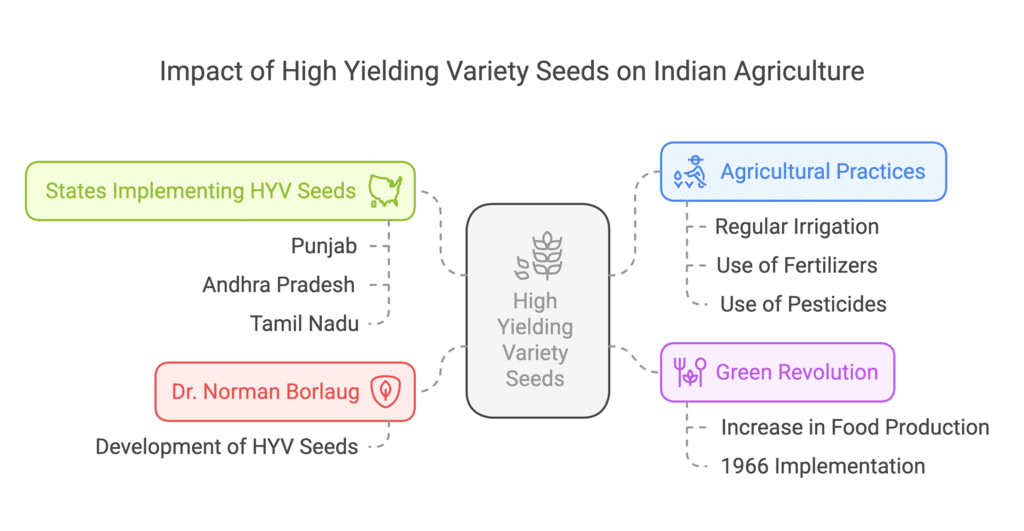
Q5: What is marketable surplus?
Ans: Marketable surplus refers to the difference between the total output produced by a farmer and his on-farm consumption. In other words, it is that portion of the total output that the farmer sells in the market.
Marketable surplus = Total farm output produced by farmer – Own consumption of farm output
Q6: Explain the need and type of land reforms implemented in the agriculture sector.
Ans: The need for land reforms in India was very necessary due to the following reasons:
- Land Tenure System: There were three types of land tenure systems namely, the Zamindari System, the Mahalwari System and the Ryotwari System prevalent in the Indian agricultural sector at the time of independence. The common feature of these three systems was that the land was mostly cultivated by the tenants and the land revenues were paid by them to their landlords. This led to the exploitation of tenants in the form of exorbitant rents.
- Size of Land Holdings: The size of land holdings owned by the farmers was very small. In addition, the land holdings were fragmented. This obstructed the use of modern techniques.
- Lack of Initiative: As most of the land was owned by the landlords, so the farmers lacked initiative and neither had enough means to undertake mechanised methods of cultivation.
- Traditional Approach and Low Productivity: Indian farmers used to rely on the conventional and the traditional inputs and methods and climatic conditions that hampered the productivity of agricultural sector.
- Absence of Marketing System: Due to the absence of well developed marketing system, the farmers used to rely on the intermediaries to sell their product in the market. These intermediaries used to purchase the farm products at a very low price and sell them at higher price at market. Consequently, the correct profit share did not accrue to the farmer and, hence, this led to the lack of finance and investment on farm.
- Nature of Farming: The basic motive for farming was for subsistence. That is, farming was done basically to earn survival and not for sale and to earn profit.
Due to the above problems in the Indian agriculture, it was very necessary to undertake land reforms.
Land reforms comprise of the following steps:
- Abolishing Intermediaries: The prime focus of land reforms was to abolish intermediaries like Zamindars, Jagirdars, etc. There were many steps undertaken to make the tillers, the owners of the land.
- Regulation of Rent: The cultivators were exploited in the form of exorbitant rents. In the first five year plan, the maximum rent fixed was one-fourth or one-fifth of the total farm produce (except in Punjab and Haryana, where it was rd). The regulations of rent not only reduced the burden from the tenants but also enabled them with greater portion of finance to invest on farm.
- Consolidation of Holdings: As the land holdings were small and also fragmented, so it was very necessary to consolidate the land holdings for the use of modern and advanced technology. The farmers were given consolidated holdings equal to the total of the land in their various fragmented plots. This enabled them the benefits associated with the large scale production.
- Land Ceilings: It means legislated fixed amount of land that an individual may hold. The basic motive behind this step was to promote equality of ownership of land holdings. This eradicated the concentration of land holdings in few hands. Government used to confiscate the excess land over the fixed amount of land and distribute it among the landless farmers.
- Co-operative Farming: This step was taken to counter the problems due to sub-division of holdings. Small scale farming by an individual land holder is neither profitable nor productive, so, these steps encouraged different farmers to pool their farms and perform farming jointly. This enhanced the productivity and greater profits were shared by the individual farmers.
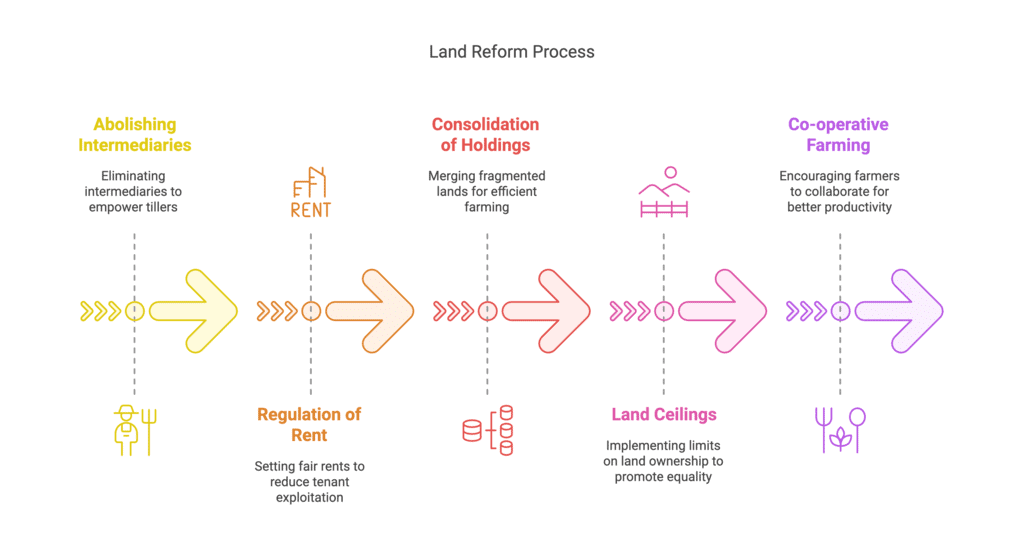
Q7: What is Green Revolution? Why was it implemented and how did it benefit the farmers? Explain in brief.
Ans: Due to low productivity, frequent occurrence of famines and low levels of agricultural products in the latter half of second five year plan, a team was formed to suggest various ways to counter these problems. As per the recommendations of the team, government introduced the use of HYV seeds, modern techniques and inputs like fertilisers, irrigation facilities and subsidised credit. These steps collectively are known as Intensive Area Development Programme (IADP). Consequently, in the year 1967-68, food grains production increased nearly by 25%. Due to this substantial increase of food grains production, this outcome is known as ‘Green Revolution’. The word Green Revolution comprises of two words ‘Green’ that is associated to crops and ‘Revolution’ is associated to the substantial increase.
Need of Green Revolution
The needs of Green Revolution are as follows.
- Low Irrigation Facility: The well irrigated and permanent irrigated area was only 17% in 1951. The major part of area was dependent on rainfall and, consequently, agriculture suffered from low level of production.
- Conventional and Traditional Approach: The use of conventional inputs and absence of modern techniques further hampered the agricultural productivity.
- Frequent Occurrence of Famines: Famines in India were very frequent during the period 1940s to 1970s. Further, due to higher growth rate of populations, agriculture failed to grow at the same speed.
- Lack of Finance (credit): Small and marginal farmers found it very difficult to get finance and credit at cheap rate from the government and banks ,hence, fell an easy prey to the money lenders.
- Self-sufficiency: Due to the traditional agricultural practices, low productivity, and to feed growing population, often food grains were imported that drained away scarce foreign reserves. It was thought that with the increased production due to Green Revolution, government can maintain buffer stock and India can achieve self-sufficiency and self-reliable.
- Marketising Agriculture: Agriculture was basically for subsistence and, therefore, less amount of agricultural product was offered for sale in the market. Hence, the need was felt to encourage the farmers to increase their production and offer a greater portion of their products for sale in the market.
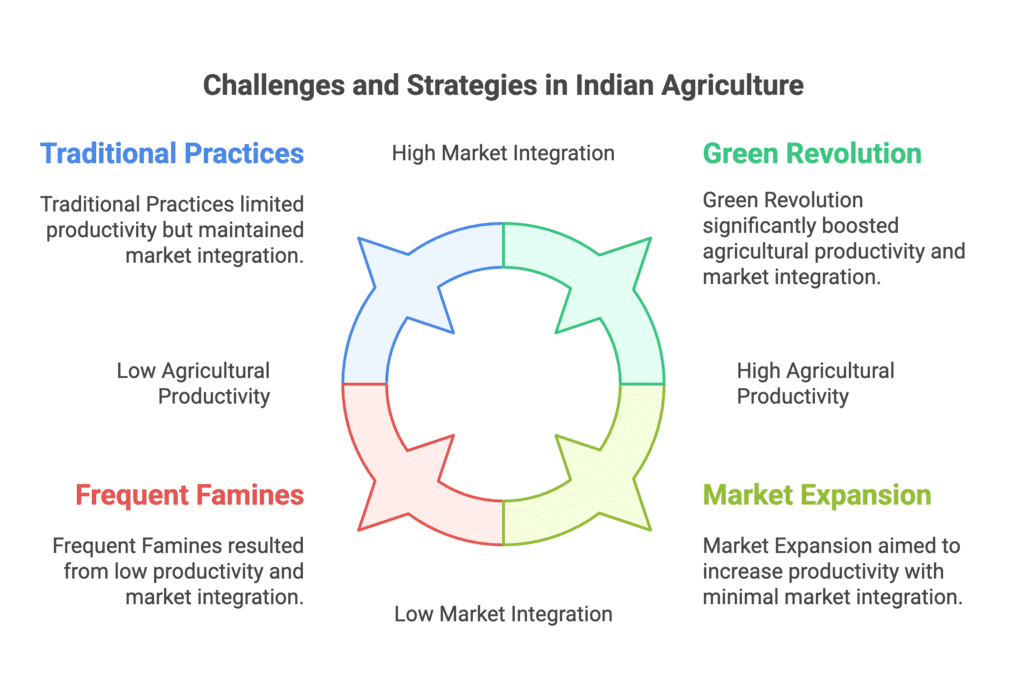
Q8: Explain ‘growth with equity’ as a planning objective.
Ans: Both growth and equity are the two important aspects of India’s five year plans. While growth refers to the increase in GDP over a long period of time equity refers to an equitable distribution of GDP so that the benefits due to higher economic growth are shared by all sections of population. Equity implies social justice. Growth itself is desirable but growth in itself does not guarantee the welfare of people. Growth is assessed by the market value of goods and services (GDP) and it may be possible that the goods and services that are produced may not benefit the majority of population. In other words, only a few with high level of living and money income may get the share of GDP. Hence, growth with equity is a rational and desirable objective of planning. This objective ensures that the benefits of high growth are shared by all the people equally and, hence, this not only leads to reduction of inequality of income, poverty promotion of egalitarian society but also enables everyone to be self-reliant. Therefore, to conclude, it can be said that growth with equity is the most important objective of an economic planning.
Q9: Does modernisation as a planning objective create contradiction in the light of employment generation? Explain.
Ans: No, modernisation as a planning objective does not contradict employment generation. In fact both modernisation and employment generation are positively correlated. While modernisation refers to the use of new and modern technology in production process that may make some people lose their jobs in the initial stages. But gradually, the use of modern technology and input will raise the productivity and, consequently, the income of the people that will further raise the demand for goods and services. In order to fulfill this increased demand, there will be more job opportunities that will lead more people to be hired and, hence, more employment opportunities will be generated. Hence, both modernisation and employment generation are not contradictory but are complementary to each other.
Q10: Why was it necessary for a developing country like India to follow self-reliance as a planning objective?
Ans: Self-reliance implies discouraging the imports of those goods that could be produced domestically. Achieving self-reliance is of prime importance for a developing country like, India as otherwise, it would increase the country’s dependence on foreign products. Dependence on foreign goods and services can promote economic growth of India but this would not contribute to the development of domestic productive resources. Dependence on foreign goods and services provides impetus to foreign country’s industries at the cost of domestic infant industries. Further, imports drain away the scarce foreign reserves that are of prime importance to any developing and underdeveloped economy. Therefore, achieving self-reliance is an important objective for developing countries in order to avoid themselves from being acquiescent to the developed nations.
Q11: What is sectoral composition of an economy? Is it necessary that the service sector should contribute maximum to GDP of an economy? Comment.
Ans: The sectoral composition of an economy is the contribution of different sectors to total GDP of an economy during a year. That is, the share of agricultural sector, industrial sector and service sector in GDP.
Yes, it is necessary that at the later stages of development, service sector should contribute the maximum to the total GDP. This phenomenon is called Structural Transformation. This implies that gradually the country’s dependence on the agricultural sector will shift from the maximum to minimum and, at the same time, the share of industrial and service sector in the total GDP will increase. This structural transformation together with the economic growth is termed as economic development.
Q12: Why was public sector given a leading role in industrial development during the planning period?
Ans: At the time of independence, Indian economic conditions were very poor and weak. There were neither sufficient foreign reserve nor did India have international investment credibility. In the facet of such poor economic condition it was only the public sectors that need to take the initiative. The following are the reason that explains the driving role of the public sector in the industrial development:
- Need of Heavy Investment: There was a need of heavy investment for industrial development. It was very difficult for the private sector to invest such a big amount. Further, the risks involved in these projects were also very high and also these projects had long gestation period. Thus, the government played the leading role to provide the basic framework of heavy industries.
- Low Level of Demand: At the time of independence, the majority of population was poor and had low level of income. Consequently, there was low level of demand and so there was no impetus for any private sector to undertake investment in order to fulfill these demands. Thus, India was trapped into a vicious circle of low demand. The only way to encourage demand was by public sector investments.
Q13: Explain the statement that green revolution enabled the government to procure sufficient food grains to build its stocks thatcould be used during times of shortage.
Ans: Green Revolution led to an increase in the production of food grains. With the use of modern technology, extensive use of fertilisers, pesticides and HYV seeds there was a significant increase in the agricultural productivity and product per farm land. In addition, the spread of marketing system, abolition of intermediaries and easy availability of credit has enabled farmers with greater portion of marketable surplus. All these factors enabled the government to procure sufficient food grains to build the buffer stock and to provide cushion against the shocks of famines and shortages.
Q14: While subsidies encourage farmers to use new technology, they are a huge burden on government finances. Discuss the usefulness of subsidies in the light of this fact.
Ans: Subsidy means availing some important inputs to farmers at a concessional rate that is much lower than its market rate. During 1960s, in order to adopt new technology HYV seeds and use of modern fertilisers and insecticides, farmers were provided inputs at a subsidised rate. Thus, the public sector role was needed to invest heavily, so as to raise the income of people that will in turn raise the demand and so on.
The following arguments are given in favour of subsidy:
- Subsidy is very important for marginal land holders and poor farmers who cannot avail the essential farm inputs at the ongoing market rate.
- Subsidy in 1960s was basically an incentive for the farmers to adopt modern techniques and vital inputs like fertilisers, HYV seeds, etc. The subsidy was mainly of convincing and lucrative nature so that the farmers do not hesitate to use these modern techniques.
- Subsidy is generally provided to the poor farmers with the motive of reducing inequality of income between rich and poor farmers and to promote an egalitarian distribution of income.
- It is argued that the adoption of new technology and techniques are not risk free and only daring farmers are only willing to adopt them.
The following arguments are given against subsidy.
- It is generally argued that subsidy favours and benefits fertiliser industries than the farmers. Subsidies provide a protective shield against the market conditions and, consequently, these industries need not to bother about their market share and competition.
- Subsidies are also enjoyed by the potential farmers who do not need them. This often leads to the misallocation and wastage of the scarce resources.
- Subsidies, if provided at a much lower rate than the market rate may lead to the wastage of resources. For example, subsidised electricity leads to the wastage of energy.
- There is a general consensus that in order to assess the benefit and feasibility of a particular technique, subsidy should be provided but once the performance has been judged subsidies should be stopped.
Hence, based on the above pros and cons, we can conclude that although subsidies are very useful and necessary for poor farmers and to overcome uncertainties associated with farming, it put an excessive burden on the scarce government finances. Thus, a proper planning, suitable reforms and allocation of subsidies only to the needy farmers is required.
 Q15: Why, despite the implementation of green revolution, 65 per cent of our population continued to be engaged in the agriculture sector till 1990?
Q15: Why, despite the implementation of green revolution, 65 per cent of our population continued to be engaged in the agriculture sector till 1990?
Ans: Although Indian agricultural production increased substantially that enabled India to attain the status of self-sufficiency in food grains but this increase is substantial only in comparison to food grain production in the past. Further, India failed to achieve structural transformation associated with the agricultural revolution and development. That is, in other words, industrial and service sector failed to generate significant employment opportunities in order to attract and absorb excess agricultural labour. The agricultural contribution to GDP has fallen from 51% in 1960-61 to 44% in 1970-71, on the other hand, the share of industry and service sector in India’s GDP increased merely from 19% to 23% and from 30% to 33% during the same period. Meantime, the percentage of population dependent on agriculture decreased merely from 67.50% (in 1950) to 64.9% (in 1990). Hence, the industrial and service sector growth was not very significant and, hence, failed to employ and attract surplus labour from agricultural sector. This may be because of the flaws in the economic policies that became the bottleneck for the growth of secondary and tertiary sector.
Q16: Though public sector is very essential for industries, many public sector undertakings incur huge losses and are a drain on the economy’s resources. Discuss the usefulness of public sector undertakings in the light of this fact.
Ans: Although, the mismanagement and wrong planning in PSUs may lead to misallocation and, consequently, to wastage of the scarce resources and finance but PSUs do have some positive and useful advantages.
- Enhancing Nation’s Welfare: The main motive of the PSU was to provide goods and services that add to the welfare of the country as a whole. For example, schools, hospitals, electricity, etc. These services not only enhance welfare of country’s population but also enhance the future prospects of economic growth and development.
- Long Gestation Projects: It was not feasible and economically viable for the private sectors to invest in the big and wide projects like basic industries and electricity, railways, roads, etc. This is because these projects need a very huge initial investment and have long gestation period. Hence, PSU is the most appropriate to invest in these projects.
- Basic Framework: An important ideology that was inherited in the initial five year plans was that the public sector should lay down the basic framework for industrialisation that would encourage the private sector at the latter stage of industrialisation.
- Socialist Track: In the initial years after independence, Indian planners and thinkers were more inclined towards socialist pattern. It was justified on the rational ground that if the government controls the productive resources and production, then it won’t mislead the country’s economic growth. This was the basic rationale to set up PSUs. These PSUs produce goods not according to the price signals but according to the social needs and economic welfare growth of the country.
- Reduce Inequality of Income and Generate Employment Opportunities: It was assumed that in order to reduce inequalities of income, eradicate poverty and to raise the standard of living, government sector should invest in the economy via PSUs.
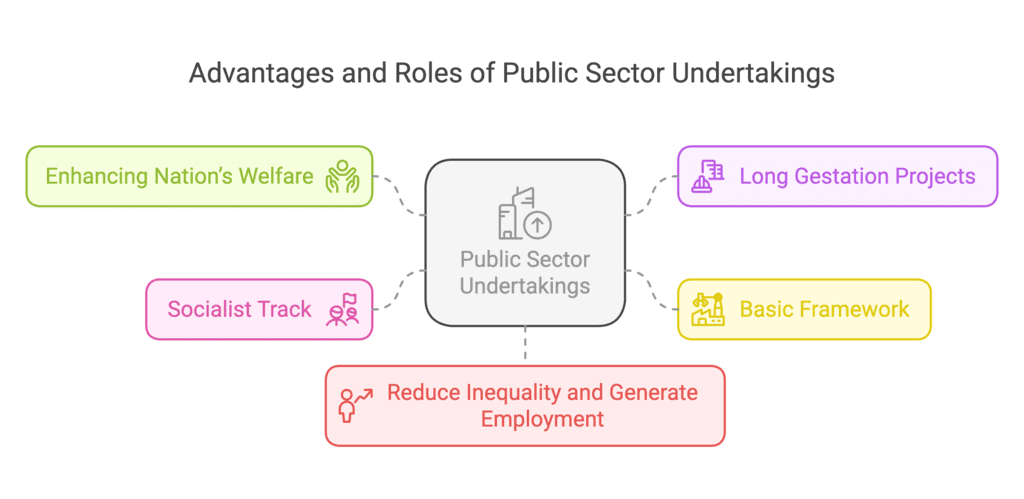
Q17: Explain how import substitution can protect domestic industry.
Ans: In the initial seven five year plans, India opted for import substitution strategy, which implies discouraging the imports of those goods that could be produced domestically. Import Substitution Strategy not only reduces an economy’s dependence on the foreign goods but also provides impetus to the domestic firms. Government provides various financial encouragements, incentives, licenses to the domestic producers to produce domestically the import substituted goods. This would not only allow the domestic producers to sustain but also enables them to grow as they enjoy the protective environment. They need not to fear from any competition and also not to worry about their market share as license gives them the monopoly status in the domestic market. Being monopolist, they earn more profits and invest continuously in R&D and always look for new and innovative techniques. This gradually improves their competitiveness and when they are exposed to the international market they can survive and compete with their foreign counterparts.
Q18: Why and how was private sector regulated under the IPR 1956?
Ans: IPR 1956 was adopted in order to accomplish the aim of state controlling the commanding heights of economy. This policy was aligned with the Indian economy’s inclination towards socialist pattern of system of Soviet Union. According to this resolution, industries were classified into following three categories:
- Category 1: Those industries that are established and owned exclusively by the public sector.
- Category 2: Those industries in which public sector will perform the primary role while the private sector will play the secondary role. That is, the private sector supplements the public sector in these industries.
- Category 3: Those industries that are not included in Category 1 and Category 2 are left to the private sector.
These industries that were left to the private sector, the government owns an indirect control by the way of license. In order to initiate a new industry, private entrepreneurs should obtain license (or permit) from the government. By licensing system, tax holidays and subsidies government can promote industries in a backward region that will ,in turn, promote the welfare and development of that region. This was supposed to reduce regional disparities.
Further, in order to expand the scale of production, private sector needs to obtain license from government. This was supposed to keep a check on the production of goods that are socially undesirable and unwanted. Hence, the state fully controlled the private sector either directly or indirectly.
Q19: Match the following: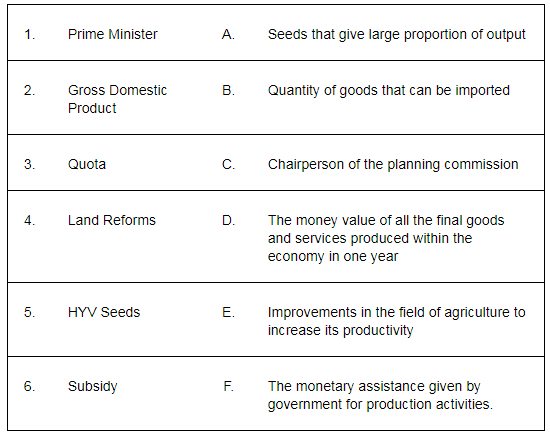 Ans:
Ans:
|
64 videos|375 docs|57 tests
|
FAQs on NCERT Solutions for Class 12 Economics - Indian Economy 1950-1990
| 1. What were the major economic policies implemented in India between 1950-1990? |  |
| 2. How did the Green Revolution impact the Indian economy between 1950-1990? |  |
| 3. What were the main challenges faced by the Indian economy during the period of 1950-1990? |  |
| 4. How did the nationalization of banks and industries impact the Indian economy between 1950-1990? |  |
| 5. How did the economic policies of 1950-1990 shape the foundation of India's economy today? |  |

















